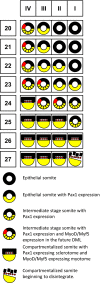Somite development in the avian tail
- PMID: 31225912
- PMCID: PMC6742930
- DOI: 10.1111/joa.13032
Somite development in the avian tail
Abstract
Somites are epithelial segments of the paraxial mesoderm. Shortly after their formation, the epithelial somites undergo extensive cellular rearrangements and form specific somite compartments, including the sclerotome and the myotome, which give rise to the axial skeleton and to striated musculature, respectively. The dynamics of somite development varies along the body axis, but most research has focused on somite development at thoracolumbar levels. The development of tail somites has not yet been thoroughly characterized, even though vertebrate tail development has been intensely studied recently with respect to the termination of segmentation and the limitation of body length in evolution. Here, we provide a detailed description of the somites in the avian tail from the beginning of tail formation at HH-stage 20 to the onset of degeneration of tail segments at HH-stage 27. We characterize the formation of somite compartment formation in the tail region with respect to morphology and the expression patterns of the sclerotomal marker gene paired-box gene 1 (Pax1) and the myotomal marker genes MyoD and myogenic factor 5 (Myf5). Our study gives insight into the development of the very last segments formed in the avian embryo, and provides a basis for further research on the development of tail somite derivatives such as tail vertebrae, pygostyle and tail musculature.
Keywords: chicken; embryo; somites; tail.
© 2019 Anatomical Society.
Figures





Similar articles
-
Developmental dynamics of occipital and cervical somites.J Anat. 2016 Nov;229(5):601-609. doi: 10.1111/joa.12516. Epub 2016 Jul 6. J Anat. 2016. PMID: 27380812 Free PMC article.
-
Distinct signal/response mechanisms regulate pax1 and QmyoD activation in sclerotomal and myotomal lineages of quail somites.Dev Biol. 1997 May 15;185(2):185-200. doi: 10.1006/dbio.1997.8555. Dev Biol. 1997. PMID: 9187082
-
Early stages of chick somite development.Anat Embryol (Berl). 1995 May;191(5):381-96. doi: 10.1007/BF00304424. Anat Embryol (Berl). 1995. PMID: 7625610 Review.
-
Expression of myogenic regulatory factors in chicken embryos during somite and limb development.J Anat. 2015 Sep;227(3):352-60. doi: 10.1111/joa.12340. Epub 2015 Jul 16. J Anat. 2015. PMID: 26183709 Free PMC article.
-
The formation of somite compartments in the avian embryo.Int J Dev Biol. 1996 Feb;40(1):411-20. Int J Dev Biol. 1996. PMID: 8735956 Review.
Cited by
-
Search for Ancient Selection Traces in Faverolle Chicken Breed (Gallus gallus domesticus) Based on Runs of Homozygosity Analysis.Animals (Basel). 2025 May 20;15(10):1487. doi: 10.3390/ani15101487. Animals (Basel). 2025. PMID: 40427364 Free PMC article.
References
-
- Bellairs R, Sanders EJ (1986) Somitomeres in the chick tail bud: an SEM study. Anat Embryol (Berl) 175, 235–240. - PubMed
-
- Borman WH, Yorde DE (1994) Analysis of chick somite myogenesis by in situ confocal microscopy of desmin expression. J Histochem Cytochem 42, 265–272. - PubMed
-
- Borman WH, Urlakis KJ Jr, Yorde DE (1994) Analysis of the in vivo myogenic status of chick somites by desmin expression in vitro . Dev Dyn 199, 268–279. - PubMed
-
- Brand‐Saberi B, Ebensperger C, Wilting J, et al. (1993) The ventralizing effect of the notochord on somite differentiation in chick embryos. Anat Embryol (Berl) 188, 239–245. - PubMed
MeSH terms
LinkOut - more resources
Full Text Sources

